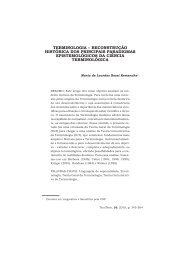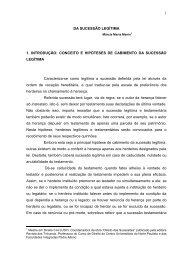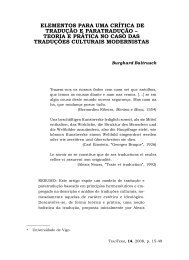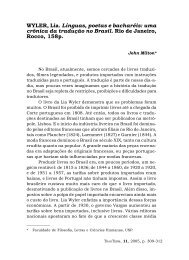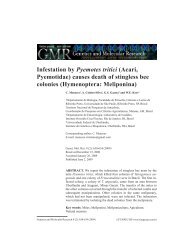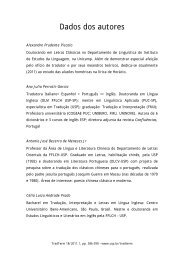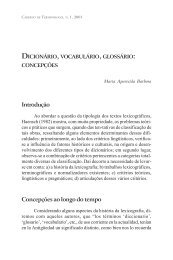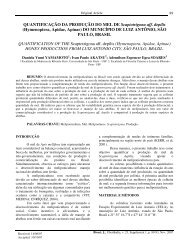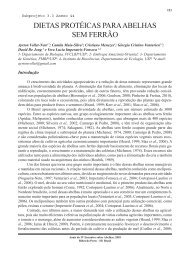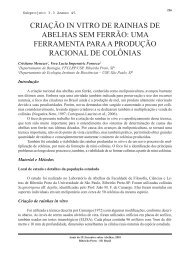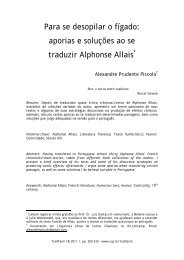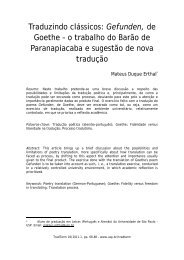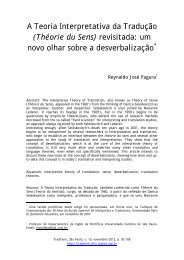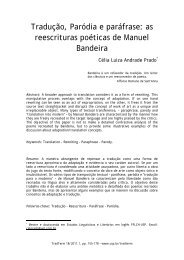Bees as pollinators in Brazil - USP
Bees as pollinators in Brazil - USP
Bees as pollinators in Brazil - USP
You also want an ePaper? Increase the reach of your titles
YUMPU automatically turns print PDFs into web optimized ePapers that Google loves.
<strong>in</strong> plants due to their co-dom<strong>in</strong>ant <strong>in</strong>heritance,<br />
high allelic diversity and their abundance <strong>in</strong><br />
plant genomes. The variability observed at SSR<br />
loci allows the accurate discrim<strong>in</strong>ation of <strong>in</strong>dividuals<br />
<strong>in</strong> natural populations and the estimation<br />
of genetic parameters, such <strong>as</strong> levels of<br />
<strong>in</strong>breed<strong>in</strong>g, heterozygosity, gene flow and mat<strong>in</strong>g<br />
system, which are relevant for the genetic<br />
conservation and management of tropical trees<br />
under <strong>in</strong>tensive human pressure. Microsatellite<br />
markers have recently been developed for a<br />
number of tropical tree species, such <strong>as</strong> the edible<br />
piqui (Collevatti, et al., 1999) and palmheart<br />
(Gaiotto, et al., 2001), and the timber species<br />
mahogany (Swietenia macrophylla, Lemes, et<br />
al., 2002, 2003), "anani" (Symphonia globulifera,<br />
Aldrich, et al., 1998), "andiroba" (Carapa<br />
guianensis, Dayanandan, et al., 1999), and<br />
"angelim-vermelho" (D<strong>in</strong>izia excelsa, Dick &<br />
Hamilton 1999).<br />
Plant reproductive biology<br />
and poll<strong>in</strong>ator behavior<br />
The importance of poll<strong>in</strong>ator visits to a plant<br />
species depends on its breed<strong>in</strong>g system. Two<br />
<strong>as</strong>pects are usually evaluated through experimental<br />
manipulation: self-compatibility and<br />
self-poll<strong>in</strong>ation. The first evaluates if a flower<br />
receiv<strong>in</strong>g pollen from the same plant is capable<br />
of produc<strong>in</strong>g viable seeds, and to what<br />
degree. If the species is self-<strong>in</strong>compatible,<br />
then it will need to be visited by <strong>poll<strong>in</strong>ators</strong><br />
that carry pollen from another plant <strong>in</strong> order<br />
to effect cross-poll<strong>in</strong>ation. Dioecious plants<br />
are obligate outcrossers. To test for self-compatibility,<br />
manual self-and cross-poll<strong>in</strong>ation<br />
experiments are performed on flowers, and<br />
the results (usually fruit and seed set) are then<br />
compared to those from control (unmanipulated)<br />
flowers. The difference <strong>in</strong> fruit or seed<br />
set also <strong>in</strong>dicates if natural poll<strong>in</strong>ation is deficient<br />
<strong>in</strong> a population. If this is the c<strong>as</strong>e, further<br />
observations should follow to see if low fruit<br />
Workshop I 49<br />
or seed set is caused by a reduced number of<br />
visits or by their quality. Poor quality visits are<br />
a result of visitors who do not perform poll<strong>in</strong>ation<br />
(thieves, for example), or who deposit<br />
the wrong k<strong>in</strong>d of pollen (self-pollen if the<br />
plant is self-<strong>in</strong>compatible, or pollen from other<br />
species if the poll<strong>in</strong>ator carries pollen from<br />
other plant species). If the plant is self-compatible,<br />
then it might not need the help of <strong>poll<strong>in</strong>ators</strong><br />
to set seeds. This is usually checked by<br />
bagg<strong>in</strong>g buds to exclude visitors and then verify<strong>in</strong>g<br />
fruit and seed set. These procedures are<br />
standard and well expla<strong>in</strong>ed <strong>in</strong> a number of<br />
books (Dafni,1992; Kearns & Inouye, 1993;<br />
Proctor, et al., 1996). In addition, data on<br />
commercially important parameters may be<br />
me<strong>as</strong>ured and compared among treatments,<br />
such <strong>as</strong> color, weight, shape, size and nutrient<br />
contents of the fruits.<br />
Different <strong>poll<strong>in</strong>ators</strong> respond to resource<br />
landscapes and this <strong>in</strong> turn h<strong>as</strong> consequences<br />
on the extent of pollen dispersal (Bronste<strong>in</strong><br />
1995). Forag<strong>in</strong>g flights may vary accord<strong>in</strong>g to<br />
the homogeneity of resources (crop vs. natural<br />
environments), plant spac<strong>in</strong>g (Man<strong>as</strong>se, 1992;<br />
Morris, et al., 1994; Morris 1993), and their<br />
flight range (Jacobi, 2000; Turch<strong>in</strong> 1998),<br />
among others. Several statistical and mathematical<br />
methods have been used to compare<br />
flight behaviour of <strong>poll<strong>in</strong>ators</strong>, particularly<br />
<strong>in</strong>sects. They rely on field data that <strong>in</strong>volve<br />
track<strong>in</strong>g techniques, such <strong>as</strong> telemetry for vertebrates,<br />
the use of dyes and the direct observation<br />
and mapp<strong>in</strong>g of flight trajectories <strong>in</strong><br />
some c<strong>as</strong>es (Turch<strong>in</strong>, 1998). These flight path<br />
analyses are sometimes compared with gene<br />
flow curves us<strong>in</strong>g marked pollen or, if available,<br />
genetically marked seeds (Kareiva, et al., 1994).<br />
All the above procedures are the b<strong>as</strong>is for<br />
pollen flow estimation, and they are useful<br />
for establish<strong>in</strong>g actions concern<strong>in</strong>g gene<br />
escape, contam<strong>in</strong>ation risk, and plant population<br />
isolation.



